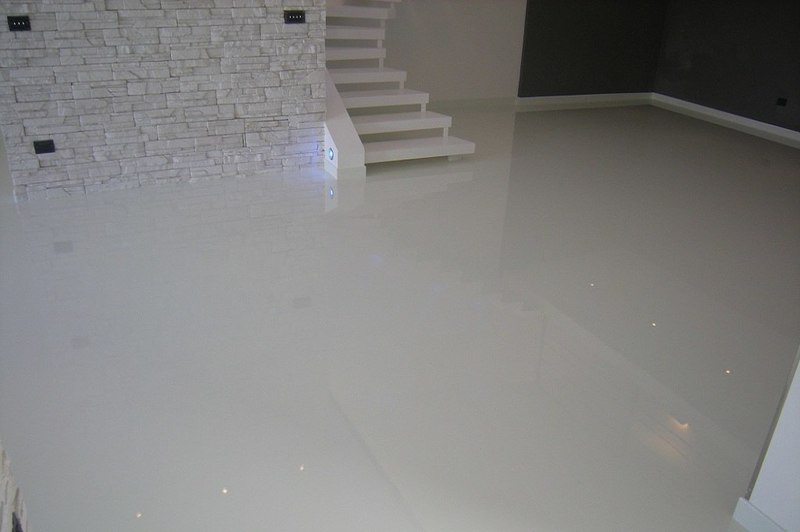Knowing how to repair water damaged epoxy concrete floors will be helpful in case your epoxy flooring gets water-damaged. The epoxy may be durable, but it is not utterly impenetrable, so we included the steps to repair them below. We also included how water damages epoxy flooring, the signs you need to watch out for, and the costs of repairing your epoxy flooring.

Steps In Repairing Water Damaged Epoxy Concrete Floors
Step #1. Remove the water
First, remove the things that would block you from adequately cleaning the space. If there is water pooling on your concrete floor, then remove that using a dry cloth. However, if it is a more significant issue, use a sump pump to dry the area.
Step #2. Assess the damage
While you can see the damage, you cannot fully evaluate it at face value. You can assess the damage to your concrete by doing a moisture test. You can check the moisture level of both the surface and the deep parts of the concrete slab.
After assessing the damage, contact professionals if you suspect a leak. Leaks cannot always be seen, so they are challenging to repair.
Step #3. Fix the damage
If the damage is only surface level, then it will be easy to fix. For example, if your concrete is spalling, then get a compound that matches your floor’s color.
Then, patch the spalled area using that compound. Let the mixture dry and smoothen the site as necessary.
You can also remove the entire slab and replace it. However, this would seem excessive and would take much of your time.
Step #4. Prevent damage
To prevent moisture-related spalling then you should seal your concrete flooring. Wait for 28 days after placing concrete, then layer it with a penetrating waterproofing sealer. Repeat this after every few years.
Step #5. Remove mold
This is an additional step in case you also struggle with mold. If your concrete has mold, it is best not to scrub it blindly, as you may just get mold spores everywhere.
Instead, use a mold-killing detergent or a bleach-water solution to kill the mold. Scrub thoroughly and make sure you get the detergent or solution down into the concrete’s pores.
How water damages your epoxy covered floors
Moisture can be trapped in your epoxy flooring after the concrete is poured. Due to the moisture being trapped, it will accumulate and cause damage first to the surface and then to the concrete slab.
The damage can be on the surface level, merely cosmetic. However, you may also encounter minor bubbles, mold, discoloration, and softening of the surface if you do not fix it immediately. It may even lead to salt bloom or efflorescence, leading to more damage to the epoxy flooring.
On occasions wherein the problem is not in the pouring of the concrete, water can still cause damage. Moisture from the soil beneath the flooring may rise and enter your epoxy covered concrete’s cracks.
This moisture intrusion damages your flooring from the inside, and you may not even notice it right away. This is why we included signs of water damage on your epoxy flooring below.
Signs that your epoxy flooring is water damaged
Cracking
Cracks are not unique to moisture intrusion. However, they may be a sign. It may also lead to vulnerability to water damage either from the leaks on your ceiling and walls or liquid spills.
When your epoxy covered concrete has cracks, you better fix them so as not to give way to moisture intrusion.
Discoloration
Moisture alters the floor’s color, so if you see your concrete with discolored areas, then your floors may be damaged by moisture.
Mold growth
Mold thrives in damp environments, and moisture intrusion in your concrete flooring is a perfect environment for it. If your epoxy covered concrete flooring has mold growing on it, then it is safe to say that your concrete is suffering from water damage.
Efflorescence
Moisture is condensed water vapor and that has salt deposits. When you see a white residue on the surface of your concrete or underneath it, that means you have a deeper water damage problem that you need to fix immediately.
Spalling
Spalling is when your floor’s surface flakes or pits. This happens when water is trapped inside the concrete’s pores which causes it to freeze and expand. The holes of the concrete would then enlarge.
Costs of repairing epoxy flooring
The average cost of repairing epoxy coated concrete is $3 to $7 per square foot. All in all, it may cost up to $3,080. However, most only spend about $1,711.
Since the cost of repairing an epoxy coat on concrete is not cheap, try to ask your insurance company about the extent of your insurance coverage when it comes to water damage. Try to ask your lawyer as well to strengthen your insurance claim.
Conclusion
After knowing how to repair water damaged epoxy concrete floors, you can now fix surface-level water damage concerns. We hope this article about water damage helped you.
